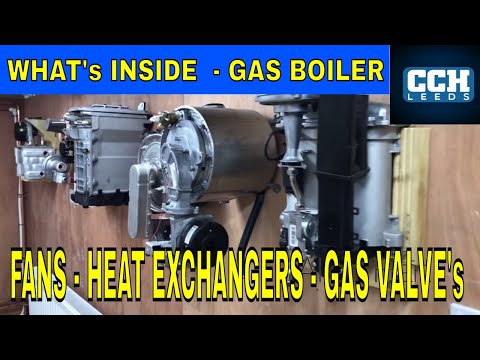Gas Training Gas Engineer showing the inside of gas boilers.
What’s inside your gas boiler. Ideal , Viessmann, Baxi, Vaillant, Ravenheat, Vokera, Worcester Bosch, So, I am going to look at heat exchanges today. So, I’ve got a few different heat exchanges here from different boilers, different makes and models of boilers. So, what I am going to do is, I’m going to strip a few of these down, strip burners out and show you inside and I’m just going to give you my opinion of different heat exchanges and if you’re going to choose a new boiler for your house.What you want really are what I would want if it were my own house. So yeah, so let’s have a look now.So first of all we’ll have a look at this heat exchanger here. So this one, this is an Ideal Logic boiler, so this could be a heat only, could be a combi.
How this would work, so to just give you a brief idea of how a heat exchanger works, here’s your gas valve. So your gas comes in here and then it goes up into the fan. Mixes in the fan. And then this ones got downward forcing burner on it. So, I will shut that down and I’ll show you inside and you can see of an idea about how it works really. And then I’ll show you some other one’s as well.
So, we’ve got all different models here. So, this heat exchanger here is that of a Viessmann boiler. We’ve got one here, this ones out of a Baxi similar heat exchanger in Vaillant boilers as well. We’ve got Worcester heat exchanger, so this is out of a CDI. So this is the flux ship boiler from Worcester. So this is an all aluminium heat exchanger. And then we’ve got another heat exchanger from Worcester.
So, if this was inside the boiler, we’d take these two screws out here. And then, on these boilers, this is the Ideal logic. When we take these two screws out of here we will be looking to see if there’s something corrupt. We’ll also be looking inside the case before, but there’s some cracks. Usually it’s about here. On this boiler.
And then, all we do is we push this up and that goes into where that flow goes. And then you go like that and then you just pull out when it’s inside the boiler. So then we take the fan out on this. So we have to disconnect this pipe off the gas valve for that.
Loosen that screw just in here so we can remove the fan.
And then your fan just lifts out. Fan comes out nice and easy. The good thing about this heat exchanger is everything is kind of easy to work on. It is a good boiler for being able to get [inaudible 00:04:04] and stuff to work on it.
And then we’ve just got some bolts on top here that we need to undo.
Sorry about that school boy error.
So we just undid these screws out of here. If you have a look on there. On there. There’s one up back there and just one there as well. So I’ll just undo them now. And then I will take this off the top.
So removed the screws, now and then that’s your burner. So your burner, you got your gas and your air mixture. Goes onto there and then that heat then goes down the heat exchanger. Down there. And then you put your water that’s inside that heat exchanger, you’ve got your flow and return pipes. So you got one pipe on one side and one pipe on the other.
So that’s the water that goes around it. So while we’re looking at this heat exchanger, I might as well show you the sump. So I’ve just removed the gas valve off the front there. And then we’ve got the sump here, so if you do ever need to change the sump, you’ve got some clips on there. And then you’ve also got some clips on the back.
So the reason this is a bit hard to get off is this there. So if you ever did need to change the sump, then if you undo this screws a little bit, you can get the sump off a bit easier. But then you’ve got some clips on there, you just pull them clips down. And the sump will come off then.
Just removed the sump totally off on this and then I can show you inside.
So that’s your sump. And then your sump has a seal, like a rubber seal. Around there as well. That’s what’s inside these boilers.
And then just to show inside.
So the next boiler or the next heat exchanger we’ve got is Viessmann boiler. So, this is a stainless steel heat exchanger. And this heat exchanger has one continuous coil. So, you’ve got a connection on there on this particular boiler it is a rubber hose. And then you’ve got a stainless steel coil around the inside. And then it’s got rubber hose on the back.
So with this, we’ve just got some screws here to remove and then that will all come out. So again with this, we’ve got the gas valve and the fan and on this one, it is connected together. But it works marvellous. Same as the Ideal logic. And it goes into there and it goes into the burner and then inside. So we’ll have a look inside this now.
So that’s your Viessmann burner. Look on there, there’s a bad staining on there so I would suggest that this hasn’t been serviced very well and it’s blocked up and backed up in past.
Video, Viva Training Academy







